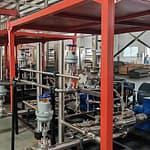Welding gas mixture – everything you need to know
1. The advantage of Ar+He argon is that the arc combustion is very stable, and the spatter is extremely small.
The benefits of helium are high arc temperature, high heat input to the base metal, and fast welding speed. Both advantages can be obtained by adding a certain amount of helium with argon as the matrix.
Argon is a colorless, odorless gas that is inert to other substances. Argon is often used when an inert atmosphere is needed. It is used in this way to produce titanium and other reactive elements.
When welding large-thickness aluminum and aluminum alloys, using an Ar+He can improve weld penetration, reduce pores, and increase productivity.
When the plate thickness is 10~20mm, the volume fraction of He is 50%; when the plate thickness is greater than 20mm, the volume fraction of 75%~90% He is added.
When welding copper and copper alloys, the mixed gas of Ar+He (fusing gas mixture)can improve the weld’s wettability and quality; the proportion of He is generally 50% to 75% (volume fraction).
2. Ar+H2 Adding H2 to argon can increase the arc temperature and the base metal’s heat input.
For example, when welding stainless steel with a TIG arc or plasma arc, a volume fraction of 4% to 8% H2 is often added to the argon gas welding gas mixture to improve the welding speed.

Ar+H2 mixed gas’s reducibility can be used to weld nickel and its alloys to suppress and eliminate CO pores in nickel welds. However, the added H2 content (volume fraction) must be less than 6%. Otherwise, it will lead to the generation of hydrogen pores.
3. Ar+N2 After adding N2 to Ar, the temperature of the arc is higher than that of pure argon. It is mainly used for welding copper and copper alloys. Compared with the Ar+He mixed gas, this mixed gas has the advantages of more sources of N2 and a lower price. The disadvantage is that there is a spatter during welding, the surface of the weld is rough, and there is a certain amount of smoke during the welding process.
4. There are two types of Ar+O2 mixed gas: one with a low O2 content (volume fraction), 1% to 5%, is used for welding stainless steel; the other contains a higher O2 content (volume fraction), which can be More than 20%, used for welding low carbon steel and low alloy structural steel.
When adding 1% O2 to pure argon to weld stainless steel, arc cathode spot instability (cathode drift) can be overcome when pure argon is used for welding stainless steel.
Cathode drift: The arc itself has jumping and sticking properties. For ferrous metals, because the oxide film on their surface is not as dense as alloys such as magnesium and aluminum, the arc always looks for oxide point aggregation on the metal’s microscopic surface in the welding process. Due to the jumping and sticking of the turn, the angle is discontinuous, and an arc offset, a cathode drift, will occur, resulting in arc instability. Adding a certain amount of oxygen will oxidize the metal surface during welding to ensure the stability of the welding arc.
5. Argon CO2 mixture
Ar+CO2 is widely used in welding carbon steel and low-alloy structural steel, which can improve the impact toughness of weld metal and reduce spatter.
6. The mixture of Ar+CO2+O2 can be used to weld low-carbon steel and low-alloy structural steel and has sound effects on weld formation, joint quality, droplet transfer, and arc stability.
What is shielding gas, and what is its purpose?
Shielding gases are inert or semi-inert gases used as part of welding processes, most notably gas metal arc welding and gas tungsten arc welding (GMAW and GTAW, more popularly known by their acronyms MIG (Metal Inert Gas) and TIG (Tungsten Inert Gas). Depending on the welded materials, they aim to shield the weld area from oxygen and water vapor that could diminish weld quality or make welding more complex. These atmospheric gases could negatively impact welding quality or complicate welding depending on the fused materials. Other welding processes employ alternative means of shielding their weld from atmospheric influences; shielded metal arc welding uses an electrode coated in flux that produces carbon dioxide as it is consumed; this semi-inert gas serves as an acceptable shielding gas when welding steel.
What Gas is Used For MIG Welding?
A commonly used gas called “C25” or “75/25” gas indicates that it contains 75% argon and 25% carbon dioxide. This mixture is the best choice if you are wondering what gas to use for MIG welds.








No comment